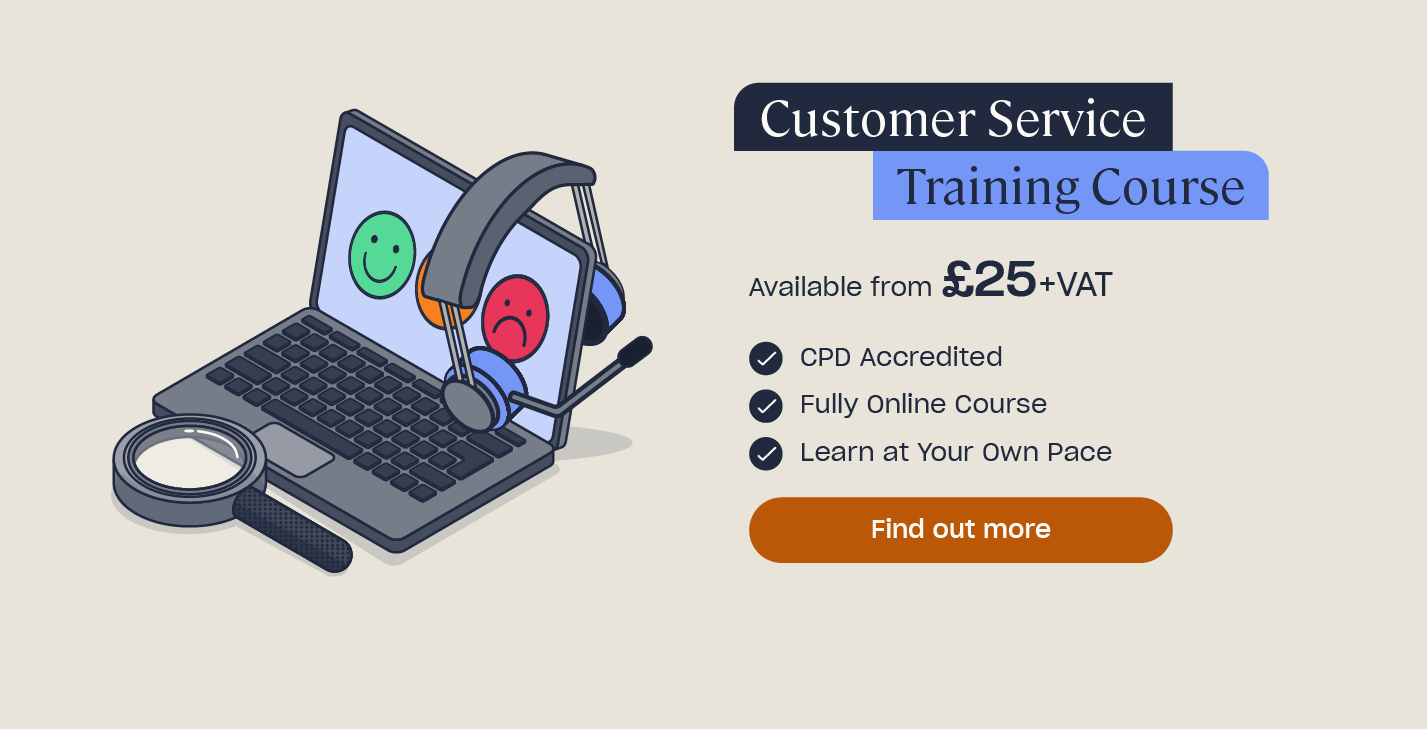How to Handle Customer Complaints
Customers are at the heart of customer service, and there is an unwritten rule – the customer is always right, even if they aren’t. Despite your best efforts, it’s likely that you will experience a customer complaint or two in your career. It takes a lot of patience and understanding to effectively deal with a customer complaint, which usually stems from a customer feeling inconvenienced or wronged in some way.
In this article, we will outline some common complaints that you may experience, and explain why these complaints can actually be beneficial. We’ll also provide guidance on how best to deal with complaints when they occur.
What is a Customer Complaint?
A customer complaint is negative feedback on a product or service that the customer has purchased or experienced.
While every complaint is different, it usually stems from a sense of dissatisfaction from the customer compared to their expectations, and this can present itself in many different ways. Often, when someone complains, they just want their feelings to be heard and have their feelings acknowledged.

For example, some of the most common complaints from customers include:
- The attitude of employees they encounter.
- Being made to wait longer than they expected.
- Mistakes from employees.
- The quality of the product or service they have paid for.
Need a Course?
Take a look at our Customer Service Training Course, which will enable you to maintain the highest standards of customer service at all times, ensuring your customers have the best experience with you. We also have a Retail Customer Service Training Course for those specifically working in a retail environment.
Examples of Customer Complaints
Customer service is a broad industry that encompasses many different roles – for example, you may work in a retail environment, a call centre or a hospitality business. However, there are common causes of customer complaints which occur in most customer service roles, and we’ve listed some of them below.
- Waiting too long – This could involve the length of queues in a store, the time the cashier takes to scan their products, or a long processing time online. There has also been a recent trend of ‘click and collect’ where a customer orders online and expects their items to be ready and waiting when they arrive.
- Staff being unapproachable – In retail businesses, it’s common for staff to have duties that put them on the shop floor. During this time, they may be approached by customers wanting information or advice. If customers feel like they’re being a burden on the staff member, this could lead to a complaint. Customer service roles can be fast-paced, where staff tend to multitask – for example, in a restaurant. This can sometimes lead to staff appearing distracted, impatient, frustrated or unapproachable, leaving the customer feeling dissatisfied with their service. Equally, customers may be unhappy with the manner or attitude of a staff member over the phone.
- Quality of product or service – This can occur in any customer service business, and present itself in any number of different ways. For example, in a restaurant, a common problem that occurs is a chef cooking a customer’s steak differently to how they wanted it. This could also include products being out of stock, damaged on arrival, or the quality of the product not matching their expectations.

- Mistakes – These can happen to any staff member at any point, regardless of experience or commitment to their role. Oversights are common when trying to juggle many tasks at once, and often, mistakes are honest.
- Returns and refunds – This can be a point of contention, whether a customer is trying to return a product without proof of purchase, the item cannot be returned, or they want a monetary refund instead of store credit.
- Billing mistakes – This could include invalid coupons, reward points, or an item being wrongly priced. It could also involve promotional deals expiring or even a technological problem in store or with online payments. These situations cause frustration and inconvenience the customer.
Need a Course?
For more information on customer complaints and other instances of conflict, consider taking a look at our Conflict Resolution Training. We also have short courses available, such as: Managing Customer Conflict in Hospitality and Managing Conflict in Retail, if you work in those industries.
If you work in hospitality, the following article may also be of interest to you: Customer Complaints in Hospitality.
Why are Customer Complaints Important?
Whilst it’s impossible to avoid complaints occurring altogether – after all, every customer is different, and will therefore react in different ways – they don’t have to mean that the company loses sales and customers. The trick is learning what causes complaints, and how to handle them efficiently and effectively.
In fact, customer complaints can actually be beneficial. Feedback is an important tool, and shouldn’t be viewed as a personal criticism. Everyone has ways in which they can improve, and the same goes for the way a business is run.
If a customer has feedback about your performance, or the business itself, the best thing to do is to embrace it. They are, after all, the ones experiencing what you are selling and they might have some valuable insight.

Also, not everyone who is dissatisfied makes a complaint. One customer may raise an issue that many others have had, and it’s important to keep that in mind. Rectifying a mistake or an issue for one customer means that you’re preventing others from feeling the same. Complaints can be learning opportunities for you to improve on in the future and make sure that you don’t make the same error twice.
The most important thing is how you handle a customer’s complaint. This can determine how efficiently the conflict is addressed and resolved, and whether or not the customer is satisfied. Customers that are impressed with your swift handling of their issue will be more likely to turn into a happy customer once again, and return to your establishment.
How to Respond to a Customer Complaint
As we’ve mentioned, it’s almost impossible to avoid experiencing a customer complaint at some point in your career. However, how you handle the complaint is the most important thing. Below we’ve compiled some tips and advice to help you deal with these situations.
Remain calm
If you find yourself dealing with a complaint, it’s important to remain calm – even if the customer or client isn’t. It can be instinctive to raise your voice if someone is shouting at you, but this will only fuel the fire and prolong the confrontation.
Some customers will become aggravated and animated when complaining. No matter their approach, you must stay professional, calm and collected. If you feel yourself getting frustrated and tempted to raise your voice, take a deep breath. The customer is more likely to positively respond to someone who is seemingly in control of themselves and the situation.
Mind your body language
Body language and other forms of non-verbal communication can tell a customer a lot about your attitude towards a situation. For example, having your arms crossed or planting a hand on your hip suggests frustration or impatience and can be seen as confrontational.
You should keep your body language approachable and calm. Having an open stance shows that you are engaging with the customer. Making eye contact is a great way to show that you’re listening to someone, for example.
Actively listen
Listen to what the customer is saying, and don’t just wait for them to finish speaking so that you can get your own opinion or perspective across. There is a difference between simply hearing and actively listening. The latter involves reacting to what has been said in a meaningful way. People can get easily frustrated if they feel they are not being heard.
Most people who are complaining just want to be heard and understood. Showing that you are actively listening can go a long way to appeasing the situation, even if you can’t completely resolve their problem.
This also means being sympathetic. Even if you disagree with the complaint, it’s important to remember that customers are the ones who are paying for your products and services. Using phrases such as, “I’m really sorry to hear this…” or, “I completely understand…” will help to make the customer feel as though you’ve taken their complaint seriously.
For more information, check out our article: How to Improve Active Listening in Communication.

Avoid deflecting the blame
Admitting to a mistake can go a long way with appeasing a customer. Equally, it’s important not to blame anyone else – this includes any other members of staff, but especially the customer themselves. Making the customer happy should be the first priority, and once that’s been achieved, you can look into what went wrong and why afterwards.
It’s important to keep in mind that the customer is paying for a service or a product that they feel hasn’t met their expectations. Acting defensively suggests they are in the wrong, and this is only going to irritate them further. It may also mean that they choose not to use your business again.
Prioritise your own wellbeing
While you need to consider the happiness of your customers, it is equally important to take care of your own mental wellbeing.
You should remember that not every complaint can be resolved. Sometimes, despite your best efforts to come up with a solution, the customer will still leave dissatisfied. In these situations, you need to be resilient and confident in yourself that you did everything you could to resolve the conflict.
It’s important to take care of your own mental wellbeing. Dealing with a complaint can add stress onto an already pressurised environment. Take five minutes to yourself to decompress, or take a few deep breaths, and try to put it behind you. Focus on being positive and delivering your excellent hospitality to your other guests.
Need a Course?
If you’re looking for more information on mental health in the workplace, and how to take proactive steps to look after your mental wellbeing, we offer a range of courses that you may find useful. This includes Mental Health Awareness, Stress Awareness in the Workplace and Mental Health and Wellbeing in Hospitality.
We hope you’ve found this article on how to promote equality and diversity in customer service both informative and helpful. If you have any further questions, or wish to find out more information on the topics covered in this article, please don’t hesitate to get in touch with us at High Speed Training!
Further Resources
- Online Customer Service Training Course
- What Defines Good Customer Service in Retail?
- Transferable Skills: What Are They and Why Are They Important?
- Complaint Handling Quiz







